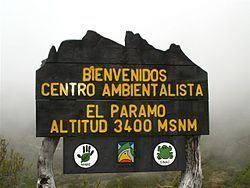 | ||
Countries Costa Rica and western Panama | ||
The Costa Rican páramo, also known as the Talamanca páramo, is a natural region of montane grassland and shrubland of Costa Rica and western Panama.
Contents
Setting
The Costa Rican páramo includes several enclaves on the highest peaks of the Cordillera de Talamanca in eastern Costa Rica and western Panama, with a total area of 31 km². The páramo is found above 3000–3100 meters elevation on the summits of Cerro de la Muerte, Cerro Chirripó, and Cerro Kamuk in Costa Rica, Cerro Echandi on the Costa Rica-Panama border, Cerro Fábrega, and Cerro Itamut in Panama.
It is surrounded at lower elevations by the Talamancan montane forests, and the World Wildlife Fund includes the Costa Rican páramo within the montane forests ecoregion, although the páramo has a distinct flora with affinities to the páramo of the Northern Andes.
Flora
The Costa Rican páramo can be divided into three zones. The subpáramo is a dwarf forest, dominated by the dwarf bamboo Chusquea subtessellata, together with short shrubs.
The páramo proper lies above the subpáramo, and is dominated by grasses, rushes, herbs, and low shrubs of the families Gramineae, Asteraceae, Cyperaceae, Rosaceae and Ericaceae. Above the páramo lies the superpáramo, a narrow zone with scarce vegetation between the grass páramo and the snow line.
Fauna
Tapir,Jaguar toucans, countless lizards and birds
